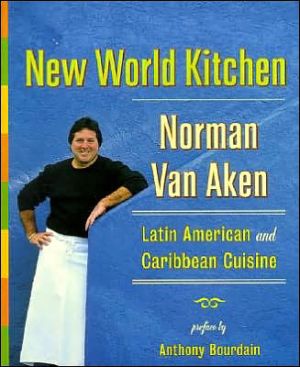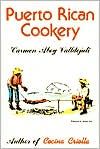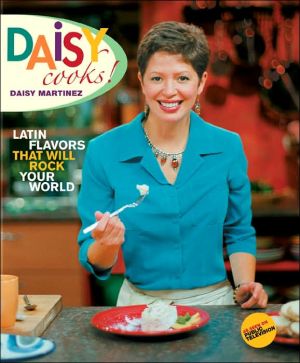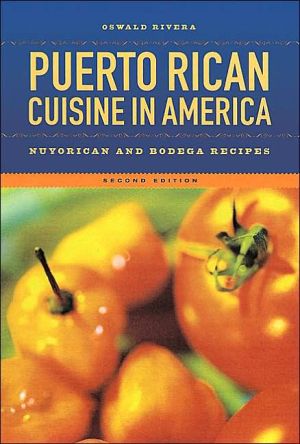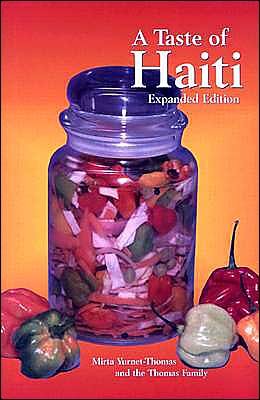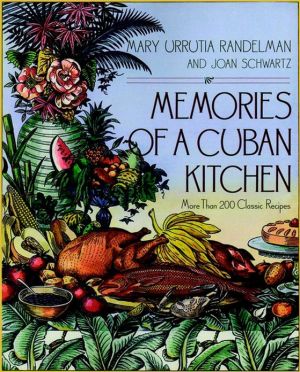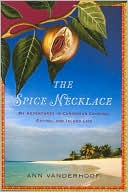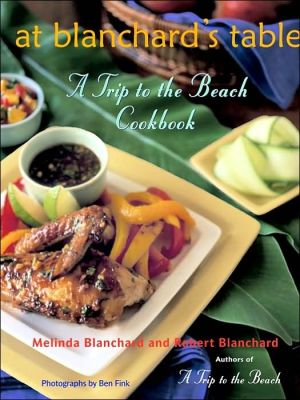New World Kitchen: Latin American and Caribbean Cuisine
In New World Kitchen, Norman Van Aken explores the rich influence of Latin American cuisine on the American palate. From the African-influenced Creole cuisines of Cuba, Puerto Rico, and Jamaica to South American flavors from Brazil, Peru, and Argentina to the distinct tastes of Mexico, Van Aken works his particular magic on this luscious cornucopia and emerges with a wealth of brilliant recipes, such as the exquisite Masa-Crusted Chicken with Piquillo Peppers, Avocado Butter, and Greens in...
Search in google:
In New World Kitchen, Norman Van Aken explores the rich influence of Latin American cuisine on the American palate. From the African-influenced Creole cuisines of Cuba, Puerto Rico, and Jamaica to South American flavors from Brazil, Peru, and Argentina to the distinct tastes of Mexico, Van Aken works his particular magic on this luscious cornucopia and emerges with a wealth of brilliant recipes, such as the exquisite Masa-Crusted Chicken with Piquillo Peppers, Avocado Butter, and Greens in Grapefruit-Honey Vinaigrette.Well known in the culinary world for his passion and genius, Norman Van Aken has earned a reputation for innovation and artistry. Armed with his signature recipes, employing a cast of rich ingredients in inventive combinations, anyone can masterfully harness the fire-and flare of Latin American cuisine. With a preface by Anthony Bourdain, author of the bestselling Kitchen Confidential, and enticing color photo graphs by Tim Turner, winner of the James Beard Foundation's award for food photography, New World Kitchen is a lush, beautiful book that new worlds of flavor. The New York Times Van Aken is a good, knowledgeable host: he's careful about providing substitutes for hard-to-find ingredients, his recipes are clean and straightforward, and he provides resources (like the list of essential books about chilies) for anyone who wants to learn more. — Dwight Garner
New World Kitchen\ Latin American and Caribbean Cuisine\ Grouper Ceviche With Three Fruit Juices Serves 6\ Tumbo, a fruit native to Peru in the same Passiflora family as maracuy, or passion fruit, was probably employed in the making of the first ceviches. It is not as acidic as lime or lemon but it is sufficiently tart to marinate fish. Today Peruvians still use the fruit to make the dish, but because it is unlikely you'll find tumbo in any grocery store north of Lima, I've used, grapefruit and lime juice here; I add passion fruit juice at the very end to make sure its distinctive taste stays clear.\ Ingredients\ 12 ounces grouper fillets\ 1 cup fresh grapefruit juice\ 1/2 cup fresh lime juice\ 1/2 Scotch bonnet chile, stemmed, seeded, and minced Kosher salt\ 1 small ripe tomato, peeled, seeded, and chopped\ 1/2 small red onion, minced\ 3 tablespoons finely diced black olives\ 2 scallions, white parts only, chopped\ 1/4 cup extra virgin olive oil\ 1 tablespoon chopped cilantro\ 1/3 cup passion fruit juice\ Freshly ground black pepper to taste\ Instructions\ Cut the grouper into 1/6-inch-thick bite-sized pieces. In a bowl, combine the grapefruit juice, lime juice, and Scotch bonnet. Add the fish and marinate, covered, for about 10 minutes in the refrigerator.\ Drain the fish in a strainer, pressing firmly to release as much moisture from the grouper as possible. While the fish is still in the strainer, salt it evenly.\ Transfer the fish to a bowl, add the remaining ingredients, and stir well. Serve.\ Recommended Wine: For a dry wine with some initial fruit offerings, such as an Arneis from Piedmont, or, for more fruit, a big-style Soave from Veneto.\ Picadillo de Pavo\ (Ground-Turkey Stew with Raisins, Green Olives, and Capers) Serves 8\ The turkey we know today is native to the New World, but its proliferation in our cuisine comes courtesy of the Spaniards, who turned out to be adept at domesticating the wild birds. Picadillo is a dish you will find in every humble Cuban café and in homes as well, but it is traditionally made with ground beef. I serve it with black beans and white rice. Prepare the picadillo while the beans and rice cook.\ Ingredients\ \ For The Picadillo\ 1/4 cup pure olive oil\ 1 1/4 pounds ground turkey (breast and leg meat mixed)\ 1 tablespoon unsalted butter\ 3 cloves garlic, thinly sliced\ 1 medium red onion, diced\ 1 red bell pepper, stemmed, seeded, and diced\ 1 yellow bell pepper, stemmed, seeded, and diced\ Kosher salt and freshly ground black pepper to taste\ 1 large tomato, peeled, seeded, and chopped\ 1/2 cup tomato paste\ 1 cup dry red wine\ 1/2 cup Spanish dry sherry\ 1/2 cup small capers, well rinsed and chopped\ 1 1/2 cup raisins or currants, roughly chopped\ 5 tablespoons lightly rinsed and roughly chopped green olives\ 3/4 cup sliced scallions (green and white parts)\ 1 recipe Black Beans (page 202), for serving\ 1 recipe Basic White Rice (page 196), for serving\ \ Instructions\ for the picadillo\ Heat a large skillet over medium-high heat and add 2 tablespoons of the olive oil. Put the turkey in the skillet and cook, separating the clumps of meat with a spoon or spatula, until crumbly and lightly browned, about 5 minutes. Transfer the turkey and any juices to a bowl. Reserve.\ Add the remaining 2 tablespoons olive oil and the butter to the skillet and heat until hot. Add the garlic, onion, and bell peppers, season with salt and pepper, and sautéfor 10 to 15 minutes, stirring occasionally.\ Stir in the turkey, tomato, tomato paste, red wine, sherry, capers, raisins, olives, and scallions. Lower the heat to medium-low, season to taste, and cook for about 15 minutes until the flavors marry. Remove from the heat.\ Spoon the rice into serving bowls, and top with the black beans. Top with the picadillo and serve.\ recommended wine: A medium-bodied Pinot Noir from Carneros or a Bourgogne Rouge from Burgundy would be seductive with the food's acidity and would sharpen the sweetness of the peppers.\ New World Kitchen\ Latin American and Caribbean Cuisine. Copyright © by Norman Van Aken. Reprinted by permission of HarperCollins Publishers, Inc. All rights reserved. Available now wherever books are sold.
AcknowledgmentsixPrefacexiIntroduction1Preparation Tips7Carnival and Street Foods12Tapas and Little Plates34Soups and Stews58Salads and Ceviches84Fish and Shellfish102Birds124Meats144Feasts and Traditions170Rice, Starches, and Other Sides192Breads216Desserts230Syrups and Sauces252The Larder258Salsas, Sauces, Mojos, Marinades, and Vinaigrettes274Cocktails292Glossary303Source Guide: Where to Buy New World Ingredients310Bibliography315Index316
\ The New York TimesVan Aken is a good, knowledgeable host: he's careful about providing substitutes for hard-to-find ingredients, his recipes are clean and straightforward, and he provides resources (like the list of essential books about chilies) for anyone who wants to learn more. — Dwight Garner\ \ \ \ \ Publishers WeeklyFive years after publishing Norman's New World Cuisine, the chef at Florida's acclaimed Norman's restaurant turns in another collection of signature fusion recipes. The selections provide an introduction to his unique blend of Caribbean, Asian and Latin and North American cooking, ranging from tapas and soups through fish and meats to basic pantry preparations and cocktails. Van Aken was not trained in a culinary school and his preparations steer clear of jargon or complex techniques; specialized ingredients are seldom more exotic than scotch bonnet chiles, tomatillos or jicama (which, nowadays, are widely available). That said, he does offer such recipes as Savory Chicken Stew with a Corn Crust and Deviled Lobster, which are straightforward but have long ingredient lists and require time and careful attention to execute correctly. Combined with Van Aken's many thoughtful sidebars and notations, the sophistication of these recipes make this a treat for serious home cooks. (Apr.) Copyright 2003 Cahners Business Information.\ \ \ Library JournalIn Van Aken's fourth cookbook (after Norman's New World Cuisine), he treads increasingly familiar ground: nuevo latino cuisine. The Miami-based chef of Norman's in Coral Gables, FL, succeeds in providing recipes of great geographic range that often share common origins or ingredients. By also including recipes from the Caribbean, he moves beyond the limits of nuevo latino cooking. The recipes, however, may intimidate novice cooks. Worse still for diet-conscious readers, a number of recipes call for frying. Although Van Aken provides wine and beer pairings for the foods, he does not suggest many ways to adapt the recipes to less well stocked pantries or to cook ahead to meet a busy schedule. Happily, the book does offer a separate chapter on beverages, something many cookbooks do not explore. However, while the recipes will lure fans of the cuisine and experienced cooks, the lack of step-by-step illustrations will put off others. Readers may wish to consider instead cookbooks by Rick Bayless, Douglas Rodriguez, or others among the bibliography that Van Aken provides. Suitable for larger public libraries. (Photos and index not seen.)-Peter Hepburn, Univ. of Illinois at Chicago Lib. Copyright 2003 Reed Business Information.\ \
